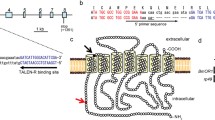Abstract
Male cabbage looper moths,Trichoplusia ni, from two colonies in which all females express an abnormal sex pheromone production phenotype were evaluated in a laboratory wind tunnel for upwind flight responses to the normal and abnormal sex pheromones. The abnormal sex pheromone blend consisted of 20 times as much (Z)-9-tetradecenyl acetate and 30-fold less (Z)-5-dodecenyl acetate compared to the normal pheromone blend. Initially, these males exhibited poor behavioral responses to the abnormal sex pheromone and maximum responses to the normal pheromone blend, indicating that there was no linkage between signal production and response. After 49 generations of laboratory rearing, males from the mutant colonies maintained good responses to the normal pheromone and increased their behavioral response to the abnormal sex pheromone to the same levels as for the normal pheromone. Over the same period, normal males maintained their preference for the normal pheromone. These results indicated that evolution had occurred in mutant colonies in favor of greater male responsiveness to the abnormal sex pheromone, resulting in the broadening of the response spectrum to pheromone blend ratios. This evolution presumably resulted from a mating advantage to those males that did not discriminate against mutant-type females in the mutant colonies.
Similar content being viewed by others
References
Alexander, R.D. 1962. Evolutionary change in cricket acoustical communication.Evolution 16:443–467.
Berger, R.S. 1966. Isolation, identification and synthesis of the sex attractant of the cabbage looper.J. Econ. Entomol. 59:767–771.
Bjostad, L.B., Linn, C.E., Du, J.W., andRoelofs, W.L. 1984. Identification of new sex pheromone components inTrichoplusia ni, predicted from biosynthetic precursors.J. Chem. Ecol. 10:1309–1323.
Cardé, R.T., andBaker, T.C. 1984. Sexual communication with pheromones, pp. 355–383,in W.J. Bell and R.T. Cardé (eds.). Chemical Ecology of Insects. Chapman and Hall, New York.
Collins, R.D., andCardé, R.T. 1989. Selection for altered pheromone-component ratios in the pink bollworm moth,Pectinophora gossypiella (Lepidoptera: Gelechiidae).J. Insect Behav. 2:609–621.
Collins, R.D., Rosenblum, S.L., andCardé, R.T. 1990. Selection for increased pheromone production in the pink bollworm,Pectinophora gossypiella (Lepidoptera: Gelechiidae).Physiol. Entomol. 15:141–147.
Haynes, K.F., andHunt, R.E. 1990. A mutation in pheromonal communication system of cabbage looper moth,Trichoplusia ni.J. Chem. Ecol. 16:1249–1257.
Kaneshiro, K.Y. 1980. Sexual isolation, speciation and the direction of evolution.Evolution 34:437–444.
Klun, J.A., andHuettel, M.D. 1988. Genetic regulation of sex pheromone production and response: Interaction of sympatric pheromonal races of the European corn borer,Ostrinia nubilalis (Lepidoptera: Pyralidae).J. Chem. Ecol. 11:2047–2061.
Löfstedt, C. 1990. Population variation and genetic control of pheromone communication systems in moths.Entomol. Exp. Appl. 54:199–218.
Löfstedt, C., Hansson, B.S., Roelofs, W.L., andBengtsson, B.O. 1989. No linkage between genes determining female pheromone production and male olfactory response in the European corn borer,Ostrinia nubilalis.Genetics 123:553–556.
Löfstedt, C., Herrebout, W.M., andMenken, B.J. 1991. Sex pheromones and their potential role in the evolution of reproductive isolation in small ermine moths (Yponomeutidae).Chemoecology 2:20–28.
Miller, J.R., andRoelofs, W.L. 1978. Sustained-flight tunnel for measuring insect responses to wind-borne sex pheromones.J. Chem. Ecol. 4:187–198.
Phelan, P.L. 1992. Evolution of sex pheromones and the role of asymmetric tracking, pp. 265–314,in B.D. Roitberg and M.B. Isman. (eds.). Insect Chemical Ecology, An Evolutionary Approach. Chapman and Hall, New York.
Roelofs, W.L., Glover, T., Tang, X.-H., Sreng, I., Robbins, P., Eckenrode, C., Löfstedt, C., Hansson, B.S., andBengtsson, B.O. 1987. Sex pheromone production and perception in European corn borer moths is determined by both autosomal and sex-linked genes.Proc. Natl. Acad. Sci. U.S.A. 84:7585–7589.
Shorey, H.H., andHale, R.L. 1965. Mass-rearing of the larvae of nine noctuid species on a simple artificial medium.J. Econ. Entomol. 58:522–524.
Sokal, R.R., andRohlf, F.J. 1981. Biometry. Freeman and Company, New York, pp. 731–747.
Todd, J.L., Haynes, K.F., andBaker, T.C. 1992. Antennal neurons specific for redundant pheromone components in normal and mutantTrichoplusia ni males.Physiol. Entomol. 17:183–192.
Author information
Authors and Affiliations
Rights and permissions
About this article
Cite this article
Liu, YB., Haynes, K.F. Evolution of behavioral responses to sex pheromone in mutant laboratory colonies ofTrichoplusia ni . J Chem Ecol 20, 231–238 (1994). https://doi.org/10.1007/BF02064433
Received:
Accepted:
Issue Date:
DOI: https://doi.org/10.1007/BF02064433




